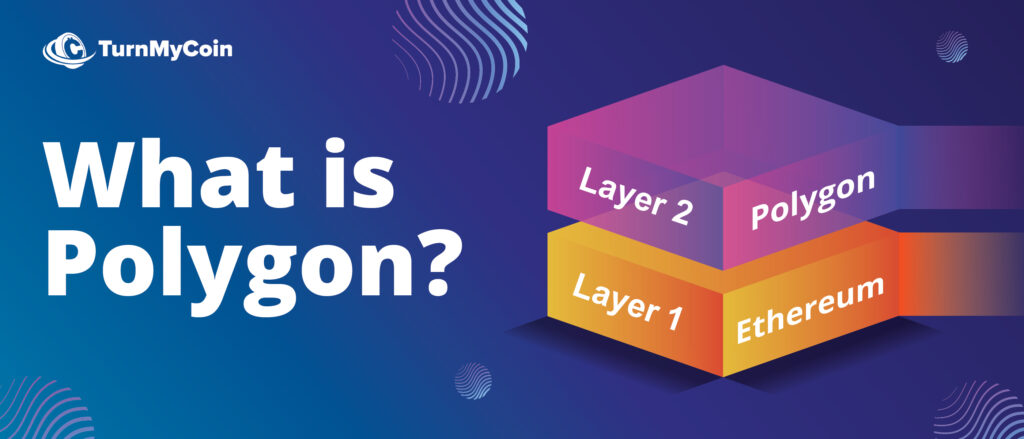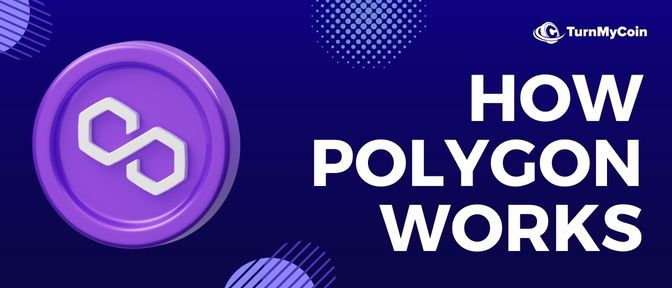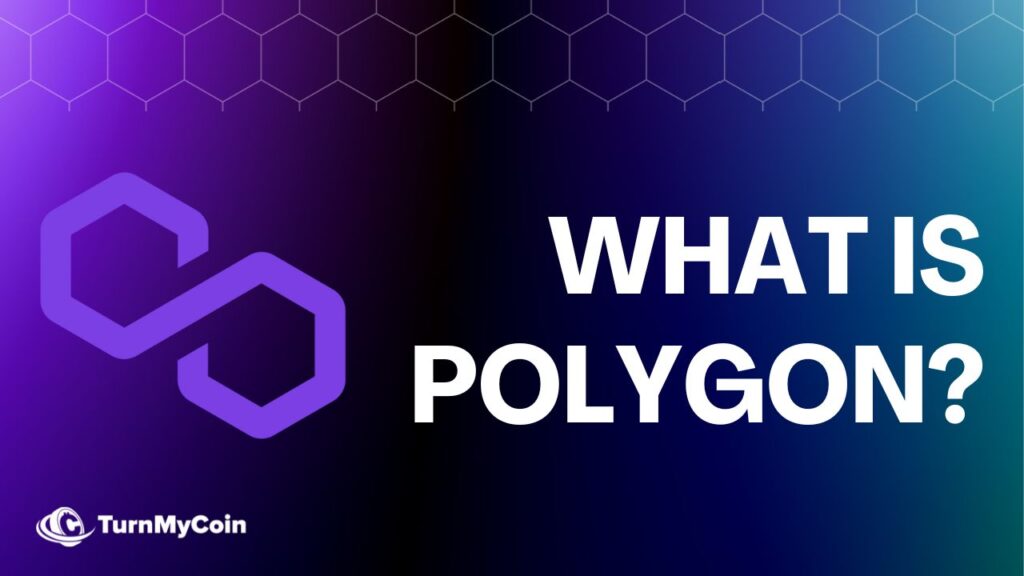Last updated on March 7th, 2023 at 11:52 am
Introduction
Polygon is a very famous cryptocurrency project that caters to the problem of the Scalability and Speed of Ethereum. Let us understand more about Polygon blockchain here.
- Introduction
- 1. What is Polygon?
- 2. Who is behind Polygon?
- 3. Are MATIC and Polygon the same thing?
- 4. How Polygon works?
- 5. How does Polygon make this more affordable?
- 6. It is not necessary for Ethereum to process all the files on its own.
- 7. Why is Polygon beneficial for Ethereum?
- 8. Polygon (MATIC) vs. Layer 1 of Ethereum.
- 9. What makes Polygon superior to Ethereum layer 1?
- 10. Isn’t Polygon no longer necessary with Ethereum 2.0?
- 11. What is so unique about Polygon?
- Summary
1. What is Polygon?

To address the scalability problems with Ethereum, a stack of protocols called Polygon was created. The Polygon network handles transactions on separate Ethereum-compatible blockchain to address the network’s problems.
Polygon blockchain then uses the main Ethereum blockchain to post-process transactions. Ethereum’s network load is reduced by this strategy. By doing this, Polygon can accelerate transactions and cut costs to under a cent.
In other words, Polygon, formerly Matic network, offers a simple framework for new and existing blockchain projects to build on Ethereum without scalability issues.
Users never have to worry about network congestion when interacting with any decentralized application (DApp) using Polygon.
This manual covers all there is to know about the Polygon Matic network, how Polygon functions, and how this ground-breaking solution is making Ethereum simpler to use.
2. Who is behind Polygon?
Due to its extremely talented development team, Polygon has firmly established itself as the most promising Ethereum scalability project. The team’s collective expertise continues to be the growth engine for Polygon.
The Matic network’s developers deserve praise for foreseeing the requirements of the current crypto industry. The next section investigates the individuals responsible for one of the projects with the fastest rate of expansion.
The three founders of Polygon
At the moment, Polygon’s cofounder Jaynti Kanani serves as CEO. Along with cofounders and chief operating officers Anurag Arjun and Sandeep Nailwal, he worked on the project. In 2017, the group of three came up with Polygon. Its previous name was Matic Network.

At first, financial support came from Mumbai, India-based friends and family. But despite having its origins in India, Polygon continues to draw investors from all over the world. In two rounds of startup funding in 2019, Polygon raised more than $450,000. The business has received about $450 million in funding from different investors.
One of the growing numbers of backers for Polygon is the angel investor Balaji Srinivasa, as well as the billionaire Mark Cuban.
3. Are MATIC and Polygon the same thing?
Before the project’s name was changed to Polygon in February 2021, it was known as Matic network. Plasma sidechains were the sole primary product of the Matic network.
In some ways, plasma chains are similar to side chains, but they provide more security in exchange for convenience. Contrary to sidechains, Plasma chains make their “root” publicly available on Ethereum layer 1 and operate under the presumption that its consensus algorithm may malfunction.
While offering greater security, this design prevents these chains from carrying out complex operations.
Polygon decided to stick with the MATIC ticker for its native token after the project grew. The Matic network changed into Polygon as a result. Even though the project’s name has changed and its branding has been updated, there may be some confusion about them. The Matic network is now under the aegis of Polygon, which unifies several projects. The native cryptocurrency of Polygon is called the Polygon (MATIC) token.
4. How Polygon works?
Polygon blockchain uses a modified Proof of Stake (PoS) consensus mechanism to validate transactions on the blockchain. In PoS, the users stake their cryptocurrency assets to form a consensus and in turn, receive rewards.
More on Proof of Stake

Polygon blockchain is a Layer 2 scaling that functions on the Ethereum Blockchain as its foundation. Vitalik Buterim has correctly mentioned the fact about Cryptocurrencies. It is called the blockchain Trilemma. It states that it is impossible to achieve all these three in blockchain:
- Speed
- Scalability
- Security
Accordingly to achieve anyone that is lacking a layer 2 solution like Polygon is needed. In the case of Polygon blockchain addresses Ethereum’s speed & scalability were issues and concurrently the Gas fees.
A set number of transactions can be processed every second on the Ethereum blockchain. For the base layer, the throughput rate is approximately 14 transactions per second. Gas fees are the transaction costs associated with each Ethereum transaction.
Gas prices increase when the network is congested, and on Ethereum, they can quickly reach $50 to $80 or more per transaction. This is a serious problem. Ethereum is completely out of reach for most users because each transaction requires a one-time payment of more than $50.
The Ethereum blockchain’s performance is also slowed by network congestion, which deters users from interacting with smart contracts on the blockchain.
For anyone who uses decentralized finance (DeFi) apps and protocols, trades or buys nonfungible tokens (NFTs), swaps, buys, or transfers tokens on Ethereum, these issues can quickly add up to hundreds of dollars in fees.
Scaling solutions like Polygon process transactions on side chains to reduce gas costs.
5. How does Polygon make this more affordable?
Compared to Ethereum, which can only handle about 17 transactions per second, Polygon can handle up to 65,000.
Additionally, Polygon blockchain can offer these fees to users for just a few cents. Compare that cost to the $15+ per transaction average transaction fee for Ethereum. Users can select the scaling option that is most appropriate for their use because Polygon includes a variety of protocols, including the zero-knowledge (zk) proof variety.
Zk proofs are a type of cryptographic primitive used to prove a statement’s validity to a third party (the verifier). However, other than proving that the assertion is true, the prover is not required to offer any further details.
Plasma sidechains, a proof-of-stake (PoS) blockchain bridge, zk rollups, and optimistic rollups are the four most popular options project teams can select to integrate using Polygon. Plasma sidechains, which are thinner and more secure sidechains, were Matic’s first choice.
A plasma chain is a second blockchain that coexists with the main blockchain, much like sidechains. The “parent” or “primary” blockchain in this instance is Ethereum. Plasma chains interact and network with the main blockchain. This enables safe asset transfers between them.
Polygon added a blockchain bridge to its product lineup in response to the strong developer demand. The PoS bridge enables developers to build DApps on a single platform without giving up the advantages provided by other platforms.
6. It is not necessary for Ethereum to process all the files on its own.
Batches of transactions can be processed on their own PoS blockchain. Polygon blockchain makes Ethereum lighter and quicker by batching transactions off the main chain.
Zk rollups process transaction bundles off-chain and generate validity proofs, confirming the accuracy of each transaction bundle. These validity proofs are then sent to the primary blockchain.
Because each validity proof serves as a stand-in for the bundle it represents, the amount of data on the main chain is decreased. This method, in practice, cuts down on the time and gas costs needed to validate a block of transactions.
Optimistic rollups employ a distinct type of proof system called fraud proofs. When a fraudulent transaction is identified, a fraud-proof protocol self-executes and determines the legitimate transaction using the information present on the primary blockchain.
Staking ETH is required for those who update transactional data on the system. As a result, anyone who uses optimistic rollups to submit a fraudulent transaction to the main Ethereum chain will have their stake reduced.
Polygon is aware that there isn’t a single ideal solution that can be used for all applications. Security, sovereignty, transaction fees, and transaction speed are all tradeoffs that each scaling solution involves. The best scaling option for each application should be available to developers. The most comprehensive suite of scaling solutions is also provided by Polygon.
7. Why is Polygon beneficial for Ethereum?
Ethereum blockchain and Polygon blockchain do not compete. The opposite is also true; it is dependent on Ethereum. Utilizing the Polygon network to build infrastructure capable of supporting the widespread adoption of Ethereum is the goal of Polygon.
The result is that Polygon is more dependent on Ethereum than Ethereum is on Polygon. As Polygon is based on its blockchain, this is to be expected.
The main drawback is that switching to Polygon for speed may dilute the value Ethereum gained. In some regions, value dilution might even prevent Ethereum from gaining more direct users.
To illustrate, Polygon enhances Ethereum, which encourages more users to use the Ethereum blockchain. Despite the possibility of stealing total value locked (TVL) away from Ethereum, the value of the Ethereum blockchain will increase as more users freely lock their money there.
8. Polygon (MATIC) vs. Layer 1 of Ethereum.
Layer-2 scaling solutions might initially seem difficult. Layer 1 summarizes the fundamental base blockchain architecture. As an overlaying network, Layer 2 is placed on top of the underlying blockchain.
External protocols interact with the base blockchain through layer-2 solutions to boost speed and effectiveness. Additionally, layer-2 solutions like Polygon can make protocols that are already operating on top of Ethereum even faster and less expensive.
9. What makes Polygon superior to Ethereum layer 1?
Due to the auction-based design of Ethereum, users are encouraged to bid for their transaction to be included in the following block. Therefore, increased network congestion naturally results in costs that become prohibitive.
Future goals for Polygon go far beyond improving speed and transaction costs. The protocol aims to connect all blockchains that are compatible with the Ethereum Virtual Machine (EVM) so that developers can easily take advantage of other blockchain platforms.
10. Isn’t Polygon no longer necessary with Ethereum 2.0?
Although Ethereum 2.0 will be a significant improvement to the Ethereum blockchain, it will only partially address the scalability issue. Demand may begin to creep up against the limits of scalability as more and more decentralized platforms and DApps use on-chain solutions like Eth2.
As previously mentioned, this causes a buildup of network traffic. Gas prices start to rise, and the network experiences a return to its previous load levels. The Ethereum blockchain needs an additional layer of scalability, which Polygon adds.
The experience offered by Eth2 will be further enhanced by Layer 2s like the Polygon network. With layer 2, any Ethereum upgrade can be completed even more quickly. The best experience for the user is made sure by Polygon in this way.
Even though Ethereum 2.0 is still a ways off, Vitalik Buterin, the man behind Ethereum, has long recognized the Trilemma challenge as a problem with scalability.
Users can take advantage of the increased speed and transparency, as well as the lower costs, of Eth2 without having to wait for the release of Eth2 thanks to a solution like Polygon.
11. What is so unique about Polygon?
Because no other layer 2 network permits its token, MATIC, to be staked on the Polygon blockchain, Polygon stands out from its rivals in this regard. Users who participate in staking can receive interest payments each year in exchange for validating transactions on the blockchain.
Developers, small businesses, and regular users can all benefit from Polygon’s solutions. The main goal of Polygon is to build an IoT (Internet of Things) for the Ethereum blockchain. Without compromising decentralization or security, the project aims to grow Ethereum to one billion users.
The methodical nature of Polygon distinguishes it from other L2 solutions. On a single network, Polygon gives developers access to a stack of solutions. With this method, developers can select the scaling solution that is best for their application with greater levels of control and customization.
A developer on Polygon has the option of using optimistic rollups or zk-rollups. They might decide to use Polygon Avail instead, a very secure data availability blockchain for stand-alone chains, sidechains, and off-chain scaling solutions.
Elements that make Polygon unique
The Polygon network announced the release of the Polygon SDK in May 2021, greatly simplifying the process for developers of creating a multichain network. Developers can build standalone chains with the Polygon SDK that are totally in charge of their own security. The dedicated PoS bridge network that connects these independent sidechains to Ethereum will be used.
Polygon also employs other scaling strategies, such as its PoS commit chain. Due to its simplicity, the commit chain is frequently referred to as Polygon or the Polygon blockchain. The project’s most well-liked offering has been Polygon’s PoS sidechain. According to information from polygonscan.com, the Polygon blockchain has handled roughly one billion transactions so far and is still growing.
Because the PoS commit chain is EVM-compatible, it is perfect with many Ethereum protocols. This makes it simple for developers to move DApps between platforms.
Summary
Polygon is a Layer 2 scaling solution that is built upon the Ethereum blockchain to increase the scalability and speed of the network. It drastically reduces the gas fees for transactions as it batch processes transactions on Ethereum.
With 65000 transactions getting processed per second, Polygon is a promising project for the future of blockchain as we know it today.


